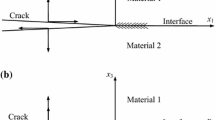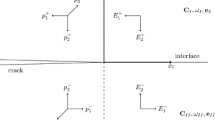Abstract
In this paper, a symplectic method based on the Hamiltonian system is proposed to analyze the interfacial fracture in the piezoelectric bimorph under anti-plane deformation. A set of Hamiltonian governing equations is derived from the Hamiltonian function by introducing dual variables of generalized displacements and stresses which can be expanded in series in terms of the symplectic eigensolutions. With the aid of the adjoint symplectic orthogonality, coefficients of the series are determined by the boundary conditions along the crack faces and along the external geometry. The stress\electric displacement intensity factors and energy release rates (G) directly relate to the first few terms of the nonzero eigenvalue solutions. The two ideal crack boundary conditions, namely the electrically impermeable and permeable crack assumptions, are considered. Numerical examples including the complex mixed boundary conditions are considered to show fracture behaviors of the interface crack and discuss the influencing factors.
Similar content being viewed by others
Abbreviations
- \({C_{44}^i,\,e_{15}^i,\,\kappa _{11}^i}\) :
-
Elastic stiffness, piezoelectric constant and dielectric constant
- \({D_r^i,\,D_\theta ^i}\) :
-
Electric displacements
- \({E_r^i,\,E_\theta ^i}\) :
-
Electric fields
- F i, Q i :
-
Body force and electric charge density
- G I, G P :
-
Total energy release rate
- H :
-
Hamiltonian function
- \({K_{\rm S}^I,\,K_{\rm S}^P}\) :
-
Strain intensity factor for two types of electric boundary conditions
- \({K_{\rm E}^I,\,K_{\rm E}^P}\) :
-
Electric field intensity factor
- \({K_3^I,\,K_3^P}\) :
-
Stress intensity factor
- \({K_{\rm D}^I,\,K_{\rm D}^P}\) :
-
Electric displacement intensity factor
- L i :
-
Lagrangian function
- U i, Π i :
-
Potential energy density function and the total potential energy
- W i :
-
Anti-plane mechanical displacement
- (x, y):
-
Cartesian coordinates
- (r, θ):
-
Polar coordinates
- \({\varepsilon _{rz}^i,\,\varepsilon _{\theta z}^i}\) :
-
Shear strains
- \({\sigma _{rz}^i,\,\sigma _{\theta z}^i}\) :
-
Shear stresses
- μ j :
-
Eigenvalue of Hamiltonian matrix
- θ 0 :
-
Angle between electrode plate and the x-axis
- ω :
-
Loading angle
- Φ i :
-
In-plane electric potential
- f i :
-
The vector of generalized external forces
- H i :
-
Hamiltonian operator matrix
- J :
-
symplectic identity matrix
- q i, p i :
-
Mutually dual vectors
- \({{\bf \Psi}^{i}}\) :
-
Complete solution in the symplectic space
- \({{\bf \Psi}_{\rm P}^i}\) :
-
Particular solution of the non-homogenous part
- \({{\bf {\varphi}}_n^{i(\alpha )},\,{\bf {\varphi}}_n^{i(\beta )}}\) :
-
Two groups of zero-eigenvalue solutions
- \({{\bf {\psi}}_j^{i(\alpha )},\,{\bf {\psi}}_j^{i(\beta )}}\) :
-
Symmetric and anti-symmetric eigensolution
- \({{\bf {\Lambda}}^{{\rm I}},\,{\bf {\Lambda}}^{{\rm P}}}\) :
-
Matrix of coefficients for the impermeable and permeable cracks
References
Fernandes A., Pouget J.: Analytical and numerical approaches to piezoelectric bimorph. Int. J. Solids Struct. 40, 4331–4352 (2003)
Li X.F., Tang G.J.: Antiplane interface crack between two bonded dissimilar piezoelectric layers. Eur. J. Mech. A Solid 22, 231–242 (2003)
Li X.F., Fan T.Y.: Mode-III interface edge crack between two bonded quarter-planes of dissimilar piezoelectric materials. Arch. Appl. Mech. 71, 703–714 (2001)
Hu K.Q., Zhong Z., Jin B.: Anti-plane shear crack in a functionally gradient piezoelectric layer bonded to dissimilar half spaces. Int. J. Mech. Sci. 47, 82–93 (2005)
Narita F., Shindo Y., Watanabe K.: Anti-plane shear crack in a piezoelectric layer bonded to dissimilar half spaces. JSME Int. J. Ser. A Solid Mech. Mater. Eng. 42, 66–72 (1999)
Narita F., Shindo Y.: The interface crack problem for bonded piezoelectric and orthotropic layers under antiplane shear loading. Int. J. Fract. 98, 87–102 (1999)
Singh B.M., Rokne J., Dhaliwal R.S., Vrbik J.: Antiplane crack at the interface of two bonded dissimilar graded piezoelectric materials. Eur. J. Mech. A Solid 27, 346–364 (2008)
Singh B.M., Rokne J., Dhaliwal R.S., Vrbik J.: Scattering of anti-plane shear waves by an interface crack between two bonded dissimilar functionally graded piezoelectric materials. Proc. R. Soc. A Math. Phys. Eng. Sci. 465, 1249–1269 (2009)
Soh A.K., Fang D.N., Lee K.L.: Analysis of a bi-piezoelectric ceramic layer with an interfacial crack subjected to anti-plane shear and in-plane electric loading. Eur. J. Mech. A Solid 19, 961–977 (2000)
Beom H., Atluri S.: Conducting cracks in dissimilar piezoelectric media. Int. J. Fract. 118, 285–301 (2002)
Wang B.L., Mai Y.W.: Fracture of a piezoelectric material layer bonded by two elastic layers. Int. J. Eng. Sci. 40, 1697–1727 (2002)
Wang B.L., Mai Y.W., Sun Y.G.: Anti-plane fracture of a functionally graded material strip. Eur. J. Mech. A Solids 22, 357–368 (2003)
Chue C.H., Yeh C.N.: Angle cracks in two bonded functionally graded piezoelectric material under anti-plane shear. Theor. Appl. Fract. Mech. 53, 233–250 (2010)
Chue C.H., Ou Y.L.: Mode III crack problems for two bonded functionally graded piezoelectric materials. Int. J. Solids Struct. 42, 3321–3337 (2005)
Ou Y.L., Chue C.H.: Mode III eccentric crack in a functionally graded piezoelectric strip. Int. J. Solids Struct. 43, 6148–6164 (2006)
Li Y.D., Lee K.Y.: Anti-plane fracture analysis for the weak-discontinuous interface in a non-homogeneous piezoelectric bi-material structure. Eur. J. Mech. A Solid 28, 241–247 (2009)
Li Y.D., Lee K.Y.: The shielding effect of the imperfect interface on a mode III permeable crack in a layered piezoelectric sensor. Eng. Fract. Mech. 76, 876–883 (2009)
Yong H.D., Zhou Y.H.: Transient anti-plane crack problem for two bonded functionally graded piezoelectric materials. Arch. Appl. Mech. 76, 497–509 (2006)
Gao C.F., Zhao Y.T., Wang M.Z.: Moving antiplane crack between two dissimilar piezoelectric media. Int. J. Solids Struct. 38, 9331–9345 (2001)
Zhou Z.G., Wu L.Z., Wang B.: The behavior of a crack in functionally graded piezoelectric/piezomagnetic materials under anti-plane shear loading. Arch. Appl. Mech. 74, 526–535 (2005)
Zhou Z.G., Du S.Y., Wu L.Z.: Investigation of anti-plane shear behavior of a Griffith permeable crack in functionally graded piezoelectric materials by use of the non-local theory. Compos. Struct. 78, 575–583 (2007)
Zhou Z.G., Wang B.: Non-local theory solution for an anti-plane shear permeable crack in functionally graded piezoelectric materials. Appl. Compos. Mater. 13, 345–367 (2006)
Zhou Z.G., Wu L.Z.: Non-local theory solution for the anti-plane shear of two collinear permeable cracks in functionally graded piezoelectric materials. Int. J. Eng. Sci. 44, 1366–1379 (2006)
Zhang P.W., Zhou Z.G., Li G.: Interaction of four parallel non-symmetric permeable mode-III cracks with different lengths in a functionally graded piezoelectric material plane. ZAMM 89, 767–788 (2009)
Kargarnovin M.H., Nasirai C., Torshizian M.R.: Anti-plane stress intensity, energy release and energy density at crack tips in a functionally graded strip with linearly varying properties. Theor. Appl. Fract. Mech. 56, 42–48 (2011)
Govorukha V., Kamlah M.: Asymptotic fields in the finite element analysis of electrically permeable interface cracks in piezoelectric bimaterials. Arch. Appl. Mech. 74, 92–101 (2004)
Sladek J., Sladek V., Wünsche M., Zhang C.: Analysis of an interface crack between two dissimilar piezoelectric solids. Eng. Fract. Mech. 89, 114–127 (2012)
Sladek J., Sladek V., Zhang C.: A meshless local boundary integral equation method for dynamic anti-plane shear crack problem in functionally graded materials. Eng. Anal. Bound. Elem. 29, 334–342 (2005)
Yao W.A., Zhong W.X., Lim C.W.: Symplectic Elasticity. World Scientific, Singapore (2009)
Zhou Z.H., Xu X.S., Leung A.Y.T.: The mode III stress/electric intensity factors and singularities analysis for edge-cracked circular piezoelectric shafts. Int. J. Solids Struct. 46, 3577–3586 (2009)
Wang J.S., Qin Q.H.: Symplectic model for piezoelectric wedges and its application in analysis of electroelastic singularities. Philos. Mag. 87, 225–251 (2007)
He X.Q., Wang J.S., Qin Q.H.: Saint-Venant decay analysis of FGPM laminates and dissimilar piezoelectric laminates. Mech. Mater. 39, 1053–1065 (2007)
Zhao L., Chen W.Q.: Symplectic analysis of plane problems of functionally graded piezoelectric materials. Mech. Mater. 41, 1330–1339 (2009)
Suo Z., Kuo C.M., Barnett D.M., Willis J.R.: Fracture mechanics for piezoelectric ceramics. J. Mech. Phys. Solids 40, 739–765 (1992)
Xu X.L., Rajapakse R.: On a plane crack in piezoelectric solids. Int. J. Solids Struct. 38, 7643–7658 (2001)
Leung A.Y.T., Xu X.S., Zhou Z.H., Wu Y.F.: Analytic stress intensity factors for finite elastic disk using symplectic expansion. Eng. Fract. Mech. 76, 1866–1882 (2009)
Pak Y.E.: Crack extension force in a piezoelectric material. J. Appl. Mech. 57, 647–653 (1990)
Liu S.H., Duan S.J., Zou Z.Z.: The stress intensity factor of a mode-III interface edge crack between two different piezoelectric materials. Eng. Mech. 22, 6–9 (2005) (in Chinese)
Author information
Authors and Affiliations
Corresponding author
Rights and permissions
About this article
Cite this article
Xu, C.H., Zhou, Z.H., Xu, X.S. et al. Fracture analysis of mode III crack problems for the piezoelectric bimorph. Arch Appl Mech 84, 1057–1079 (2014). https://doi.org/10.1007/s00419-014-0848-8
Received:
Accepted:
Published:
Issue Date:
DOI: https://doi.org/10.1007/s00419-014-0848-8




